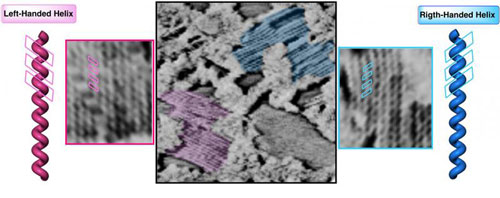| Posted: Mar 02, 2016 |
New AFM methodology allows direct visualization of the structure of helical polymers
(Nanowerk News) The three-dimensional structure of many molecules is directly related with their function, i.e. the proteins. Thus, it is very important to obtain the information which allows the determination of the structures. But, when talking about polymers, the already developed methods for biomolecules do not provide enough information to know its structure.
|
|
This research has developed a new methodology that allows direct visualization of the structure of helical polymers by atomic force microscopy (AFM). To this end, researchers have been used a general technique known as Langmuir-Schaefer, allowing the preparation of monolayers. In this case, they achieved ordered monolayers of helical polymers on a hydrophobic substrate ("Helical sense selective domains and enantiomeric superhelices generated by Langmuir–Schaefer deposition of an axially racemic chiral helical polymer").
|
 |
| AFM image of the monolayer, showing left- and right-handed helical fields (highlighted in pink and blue, rspectively)
|
|
Using this method, the researchers have been able to determine the structure of a polymer which comprises both helical senses —right- or left-hand senses— in the same proportion (i.e. a racemic mixture), which is not possible with currently available techniques such as circular dichroism.
|
|
This information is very relevant becasuse of the structure of these helical polymers is a key to address the design of new applications based on the structure thereof, such as sensors and catalysts.
|
|
This research has been supervised by Félix Freire (Ramón y Cajal Researcher) and carried out Rafael Rodríguez (pre-doctoral researcher), members of the Research Group of Emilio Quiñoá and Ricardo Riguera, also co-authors of these work, together with Jordi Ignés Mullol and Francesc Sagués from the Institut de Nanociència i Nanotecnologia (Universitat de Barcelona).
|
|
Technical note
|
|
This is the first example of a chiral, dynamic helical polymer that shows such sense-selective packing in the 2D crystal. The polymer behaves as a dynamic “racemic” mixture of left and right-handed helices in solution, but during its Langmuir-Schaefer deposition on graphite, it produces separate chiral 2D monolayer fields formed by selective packing of either left- or right-handed helical structures (but not fields by mixed senses). The sense-selectivity packing of the polymer in the 2D crystal is also demonstrated by the presence of separate right- and left-handed coiled-coil superhelices.
|
|
It is necessary to stress also the importance of the Langmuir-Schaefer (LS) deposition technique used for the first time in this work to generate 2D monolayers useful to obtain high-resolution AFM images. This technique has shown to be crucial to obtain good quality monolayers from helical polymers, where other techniques such as spin coating, drop casting and Langmuir–Blodgett (LB) failed. Key helical parameters (i.e., sense, pitch, packing angle) are easily measured in this way.
|

